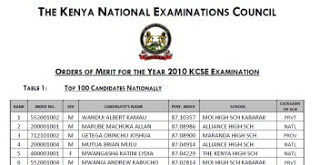KCSE 2010 Results - Poor Performance
Originally posted on 2011-03-05T19:39:00Z at http://theonlinekenyan.com/2011/03/kcse-2010-results-poor-performance.html
Go to: KCSE 2010 Results | KCSE 2011 Results
KCSE 2010 had 213,438 candidates scoring C- and below. The large number accounts for an astonishing 60% of those who sat for the exams. Whereas the examination was sat by 357,488 candidates, only 27 per cent obtained mean grade of C+ and above, which is considered the minimum university entry benchmark.
St Mark's High School was last with a mean grade of only 1.58 sat on the edge of D-. Out of 76 candidates, 39 scored E, 29 D- and 7 D. Only one candidate managed a D+. Second from bottom was Eastern Province’s Kyulu Secondary School which had a performance index of 1.64. The best student in a class of 25 had D, 14 D- and 10 E. Bute Girls Secondary School in North Eastern Province was the third worst performer. Some 22 of its candidates obtained a mean grade of E, while 13 had D-. Nairobi’s Guru Nanak Secondary School had a mean of 1.8. Eighteen of its candidates scored E.
Nyanza Province had the highest number of schools in the bottom 50 institutions. It contributed 17 candidates to the list of failures. It was followed by Central with 10 schools, Eastern seven, Coast six and Nairobi five. Rift Valley had only two schools on the list, while North Eastern had one. There was no school from Western on the list.
A massive 154,830 students representing 43 per cent of the total candidature obtained D+, D, D- and E, the lowest grades in the KCSE ranking. To make the matter worse the number of candidates who obtained grades of D- and E last year stood at 47,405, compared to only 8,131 students who obtained the first two top grades of A and A-.
Over 5,500 secondary schools across the country have limited capacity to prepare their students for higher education and further training. Whereas those schools would like to link their poor performance to limited resources, emerging evidence indicate poor administrative style, chronic teacher and student absenteeism and student indiscipline as key to poor performance recorded by that category of schools.
The Reason?
Only 3 district public schools were among the top 100 schools. These were Molo Academy, AIC Chebisaas Boys’ Secondary School and Nyakoiba Secondary School. This in sharp contrast with the emerging high cost private secondary schools that took 28 slots of the best 100 schools in the country. Read on KCPE Results for 2010."We think people might be complacent for living near the city. Some of our teachers could be involved in businesses, tuition in private schools or other activities outside their core teaching duties," Mr Patrick Nyagosia, Central Province Director of Education, on Central province’s poor performance back in 2009.
Why Schools Fail:
- Admission – High performing schools get the best crop off primary schools and these schools in the bottom lot get a raw deal. And the cycle continues on and on, feeding unto itself.
- Staff – Poor staffing of these institutions. Few teachers meaning the children are inadequately. Saturday Nation investigations established that some teachers in the worst performing schools were sub-contracting Form Four graduates, some of whom scored as low as D+, to teach on their behalf.
- Resources – Most of these institutions, especially in the arid regions, lack sufficient resources. Be it lab equipment, books, or even desks to sit in, not having a good enough environment to compete on the same level as Alliance or even Maranda.
- Community – the Director of Education (Secondary Schools) Mr Robert Masese said that some communities had given up helping schools within their precincts preferring to send their students to well performing ones away from home
- Government – To be honest, the government is on the list because it never does anything right; from corruption, CDF mismanagement, misappropriation of resources… [ name it, they do it]
- Drought and Insecurity – Mr Masese added that insecurity and drought in the N. Eastern Province was an issue affecting enrolment and performance
- Indiscipline– Teacher and Student absenteeism, student indiscipline
- Poor Administration – Most of these institutions are poorly run.
When it is becoming apparent that of the 2010 KCSE lot only those that attained B and above may get slots in local universities, the government needs to spell out better avenues for the rest.
